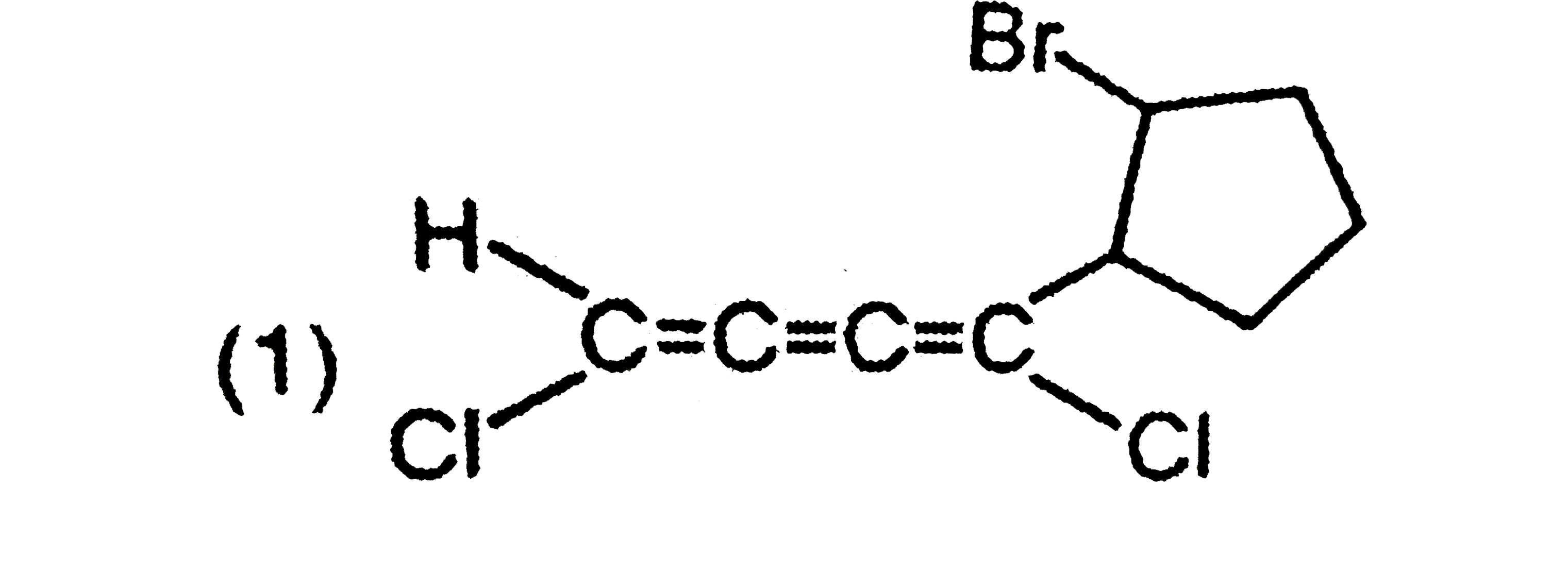Which of the following compunds is capable of showing geometrical, optical and conformational isomerism.

H2C=CH−C∣OHH−CH3
CH3−CH=CH−CH2−CH2−OH
H2C=CH−CH2−OH
The correct Answer is:A
To determine which of the given compounds is capable of showing geometrical, optical, and conformational isomerism, we will analyze each type of isomerism step by step.
Step 1: Analyze Geometrical Isomerism
Geometrical isomerism occurs due to the restricted rotation around a double bond or a ring structure, leading to different spatial arrangements of substituents.
1. Compound 1: This compound has an allene structure with consecutive double bonds, making it planar. It can show cis-trans isomerism because the substituents can be arranged differently around the double bond.
- Conclusion: Shows geometrical isomerism.
2. Compound 2: This compound has two identical groups (H) on one side of the double bond, which means it cannot exhibit geometrical isomerism.
- Conclusion: Does not show geometrical isomerism.
3. Compound 3: This compound has different groups on either side of the double bond (H and CH3 on one side, H and CH2CH2OH on the other). Thus, it can show E/Z isomerism.
- Conclusion: Shows geometrical isomerism.
4. Compound 4: Similar to Compound 2, it has two identical groups on one side, so it cannot exhibit geometrical isomerism.
- Conclusion: Does not show geometrical isomerism.
Step 2: Analyze Optical Isomerism
Optical isomerism occurs when a compound has chiral centers, leading to non-superimposable mirror images.
1. Compound 1: Contains a chiral center (carbon attached to different substituents), hence it can show optical isomerism.
- Conclusion: Shows optical isomerism.
2. Compound 2: Contains a chiral center as well, thus it can show optical isomerism.
- Conclusion: Shows optical isomerism.
3. Compound 3: This compound does not have any chiral centers, so it cannot show optical isomerism.
- Conclusion: Does not show optical isomerism.
4. Compound 4: Similar to Compound 3, it lacks chiral centers, hence does not show optical isomerism.
- Conclusion: Does not show optical isomerism.
Step 3: Analyze Conformational Isomerism
Conformational isomerism arises from the rotation around single bonds, leading to different spatial arrangements (conformers).
1. Compound 1: Being planar, it does not have conformational isomerism.
- Conclusion: Does not show conformational isomerism.
2. Compound 2: This compound can exhibit conformational isomerism due to the presence of different substituents that can adopt staggered or eclipsed conformations.
- Conclusion: Shows conformational isomerism.
3. Compound 3: This compound also has the ability to show conformational isomerism due to the presence of single bonds allowing rotation.
- Conclusion: Shows conformational isomerism.
4. Compound 4: This compound does not have any conformational isomerism due to its structure.
- Conclusion: Does not show conformational isomerism.
Final Conclusion
Based on the analysis:
- Compound 1: Shows geometrical and optical isomerism but not conformational.
- Compound 2: Shows optical and conformational isomerism but not geometrical.
- Compound 3: Shows geometrical and conformational isomerism but not optical.
- Compound 4: Does not show any of the isomerisms.
Thus, Compound 2 is the only compound capable of showing geometrical, optical, and conformational isomerism.
Geometrical isomerism occurs due to the restricted rotation around a double bond or a ring structure, leading to different spatial arrangements of substituents.
- Conclusion: Shows geometrical isomerism.
- Conclusion: Does not show geometrical isomerism.
- Conclusion: Shows geometrical isomerism.
- Conclusion: Does not show geometrical isomerism.
Optical isomerism occurs when a compound has chiral centers, leading to non-superimposable mirror images.
- Conclusion: Shows optical isomerism.
- Conclusion: Shows optical isomerism.
- Conclusion: Does not show optical isomerism.
- Conclusion: Does not show optical isomerism.
Conformational isomerism arises from the rotation around single bonds, leading to different spatial arrangements (conformers).
- Conclusion: Does not show conformational isomerism.
- Conclusion: Shows conformational isomerism.
- Conclusion: Shows conformational isomerism.
- Conclusion: Does not show conformational isomerism.
Based on the analysis:
- Compound 1: Shows geometrical and optical isomerism but not conformational.
- Compound 2: Shows optical and conformational isomerism but not geometrical.
- Compound 3: Shows geometrical and conformational isomerism but not optical.
- Compound 4: Does not show any of the isomerisms.
Topper's Solved these Questions
- STEREOISOMERISMBOOK - RESONANCE ENGLISHCHAPTER - STEREOISOMERISMEXERCISE - EXERCISE (PART II : NATIONAL STANDARD EXAMINATION IN CHEMISTRY (NSEC) STAGE-1)
55 Videos
- STEREOISOMERISMBOOK - RESONANCE ENGLISHCHAPTER - STEREOISOMERISMEXERCISE - EXERCISE (PART III : PRACTICE TEST-2 (IIT-JEE (ADVANCED PATTERN))
23 Videos
- STEREOISOMERISMBOOK - RESONANCE ENGLISHCHAPTER - STEREOISOMERISMEXERCISE - EXERCISE (PART -II ONLINE JEE MAIN)
3 Videos
- SOLUTIONSBOOK - RESONANCE ENGLISHCHAPTER - SOLUTIONSEXERCISE - Advabced Level Problems (PART-2)
35 Videos
- STRUCTURAL IDENTIFICATIONBOOK - RESONANCE ENGLISHCHAPTER - STRUCTURAL IDENTIFICATIONEXERCISE - Advanced level Problems (Part-III)
12 Videos
Similar Questions
Knowledge Check
Which of the following compound can show geometrical isomerism ?
A B
B C
C D
D
Which one of the following compounds will show geometrical isomerism ?
ACH3−CH=CH2BCH3−C∣CH3=CH2CCH3−C∣CH3=CHDDCH3=CH=CHDWhich of the following compounds can exhibit geometrical isomerism?
AH3C−CH2−CH=CH−CH3B C
C D
D
Which of following is/are capable of showing geometrical isomerism:
View SolutionWhich of the following compound can not show geometrical isomerism?1
View SolutionWhich of the following compound will show geometrical isomerism?
View SolutionWhich among the following compounds will show geometrical isomerism.
View SolutionWhich of the following compounds will exhibit geometrical isomerism?
View Solution
